The ASUS ROG Maximus X Apex Review: X Marks the Spot, Literally
by Joe Shields on May 11, 2018 9:00 AM EST- Posted in
- Motherboards
- Intel
- Asus
- ROG
- Aquantia
- 5G
- Coffee Lake
- Z370
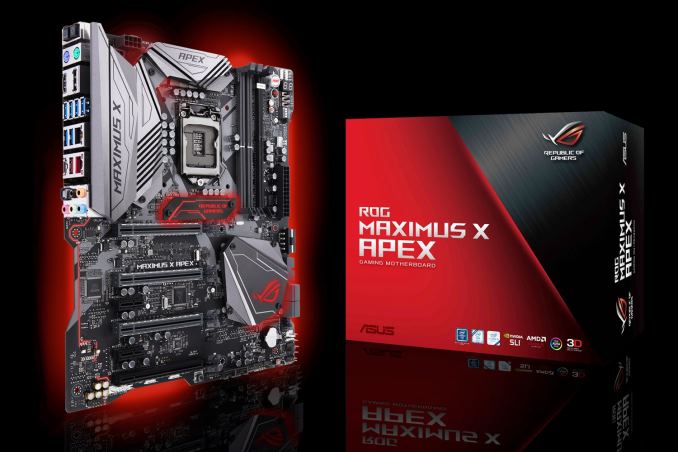
The ASUS ROG Apex line of boards have always been known for its focus on overclocking as well as unique design implementations like the "X" shaped board and the unique 'DIMM.2' slot - a DRAM-like slot for a bundled add-in card that can be used for two additional M.2 modules on a PCIe 3.0 x8 link. The Z370 ROG Maximus X Apex sticks with its pedigree and even adds a 5G network port to a long feature list.
AnandTech Intel Z370 Motherboard and CPU Coverage
- The Anandtech Coffee Lake Review: Initial Numbers on the Core i7-8700K and Core i5-8400
- Analyzing Z370 for Intel's 8th Generation Coffee Lake: A Quick Look at 50+ Motherboards
- ($397) The ASUS ROG Maximus X Apex Review [this review]
- ($250) The NZXT N7 Z370 Review [LINK]
- ($191) The SuperO C7Z370-CG-IW Review [LINK]
- ($180) The ASUS Z370-I Gaming [planned]
- ($150) The GIGABYTE Z370 Ultra Gaming Review [planned]
- ($144) The GIGABYTE Z370 Gaming WiFi Review [planned]
ASUS ROG Maximus X Apex Overview
Straight off the bat, it is hard to ignore that the Apex is not a rectangular motherboard. ASUS has cut the Apex into a more esoteric shape, almost like an X, to differentiate itself from other products on the market. It is a little odd, given generations of rectangles, although it is worth noting that motherboards do not have to be rectangles at all - as long as it fits in the standard, go crazy. The Apex fits the standard, requiring an E-ATX chassis, and the extra PCB area is used extensively for features.
The Maximus X Apex, by both pricing and feature set, places it in the high-end enthusiast segment for the Z370 platform. The Apex includes a lot of features focused on overclocking but is well rounded enough to do anything from gaming to workstation level activities. An example of the overclocking pedigree is in the upper right-hand corner, where there are several buttons, switches, and voltage read points that are all dedicated overclocking features to make extreme competitive overclocking easier.
To that end, the board uses two DRAM slots rather than the four we would normally expect to see on full-size, premium cost motherboards. ASUS mentions this was done to have better trace routing and helps with higher memory speed support, but also gives room for features such as DIMM.2, as shown below. The Apex also includes an Aquantia AQC108 5G LAN port for faster network connectivity and also has a bright RGB LED implementation. The ROG Maximus X Apex is a board aimed at users who want all of the performance out of this platform while not falling short most anywhere else.
The performance results for the Maximus X Apex placed it at the top of most of our benchmarks so far, leading nearly across the board from our small set of 300-series boards. The only point to pick up on might be the idle power consumption being higher, but that should be expected with a board like this with the extra functionality.
When manually overclocking our i7-8700K, it was met with no resistance from the board itself. We were easily able to push this CPU to 5.1 GHz passing our tests. 5.2 GHz brought us to a major voltage wall requiring an additional 0.1 volts, pushing our CPU temperatures well past the 90C limit we use. The automated overclocking (5-Way Optimization) through AI Suite 3 yielded a slight increase in performance, about 100 MHz for all threads (including AVX offset) and 300 MHz for single threaded clock speeds. The large aluminum heatsink covering the power delivery was able to keep them well within specification regardless of manual or auto overclocking.
The ROG Maximus X Apex removes M.2 connections on the motherboard and relies solely on the DIMM.2 add-in-card to attach any M.2 devices (SATA, PCIe, Optane). The add-in-card comes with a bracket in order to attach fans (sold separately) used to cool the devices below it. For SATA connected storage, the Apex gives users four ports, supporting RAID 0/1/5/10. The platform typically includes six SATA ports which are native to the chipset, but with four in use allows the board not to share PCIe resources with the SATA ports.
Somewhat unusual for the mainstream Z370 platform, the Apex comes with a total of four full-length PCIe slots (and two PCIe x1 slots). Three of the four full-length slots (grey reinforced) are connected to the CPU and will run at x16, x8/x8, or x8/x4/x4. The full-length slot at the bottom runs at x4 speeds from the chipset, and the x1 slots run at x1. This configuration allows the Apex to support both SLI (two card) and up to 4-way Crossfire.
The Apex has two USB 3.1 ports, Type-A and Type-C, located on the back panel IO and fed by the ASMedia ASM3142 controller. Sourced from the chipset are eight USB 3.0 ports with six on the back panel and the rest found as headers on the motherboard. It also includes six USB 2.0 ports via internal headers only.
The wired networking side of things is where ASUS really separates this board from most other Z370 options, including an Aquantia 5G network port alongside an Intel I219-V gigabit Ethernet port. I believe ASRock is the only other board partner to have anything above the gigabit mark. There is no wireless option here - the 5 GbE may be welcome to some, though I would imagine if there were a choice of options between wireless and 5 GbE, most users would select the wireless component as the infrastructure for multi-gigabit ethernet in the home still lags behind what enthusiasts have been demanding.
Competition
The Apex is not the highest end overclocking motherboard that ASUS offers on Z370, so one might assume that it does not compete directly with other halo motherboards. Ultimately it squares against anything that the competition has geared towards overclocking. Normally this would be products like the GIGABYTE SOC Force, the ASRock OC Formula, and the MSI XPower, however there is no Z370 SOC Force, there is no Z370 OC Formula, and there is no Z370 XPower. The other main manufacturers have focused moreso on gaming related models for Z370, tying in various OC features as required by the pricing segment. This is an odd situation to be in.
As we discovered recently, Intel is planning a Z390 chipset launch later this year, where the other manufacturers could be leaning towards that time frame for those versions of their motherboards. ASUS might also be doing this, as it has only launched the Hero/Code/Apex/Formula so far on Z370, and we have not yet seen the ROG Impact or ROG Extreme at this time.
The only motherboards near the Apex in Price currently are the ASUS Maximus X Formula ($450 MSRP, on sale for $350), ASRock's Z370 Professional Gaming i7 (MSRP $300, currently $285), ASUS's own Maximus X Code ($280), GIGABYTE's Z370 Gaming 7-OP ($270), EVGA's Z370 Classified K (MSRP $280, currently $236), and MSI's Z370 Godlike Gaming (limited edition).
ASUS Z370 Strategy
ASUS brings a number of Z370 motherboards to the table ranging from the Mini-ITX Z370-I Gaming to the flagship Maximus X Formula. The Republic of Gamers boards consisting of the Maximus and Strix series are most of the lineup, with the TUF and Prime lineups each having two boards. Prices range from $130 (Newegg) TUF-Plus for entry-level up to the flagship ROG Maximus X Formula at $441 (Amazon). It's a pretty wide price range with boards of all shapes, sizes, sizes and included features.
| ASUS' Z370 Motherboard Lineup (5/11) | |||
| AnandTech Review |
Amazon | Newegg | |
| ROG Maximus X Formula | $350 | $350 | |
| ROG Maximus X Apex | [this review] | $318^ | $318 |
| ROG Maximus X Code | $279 | $280 | |
| ROG Maximus X Hero Wi-Fi AC | $260 | $260 | |
| ROG Maximus X Hero | - | $241 | |
| ROG Strix Z370-F Gaming | $202^ | $180 | |
| ROG Strix Z370-E Gaming | $187 | $200 | |
| ROG Strix Z370-G Gaming | $196 | $208 | |
| ROG Strix Z370-H Gaming | $156 | $156 | |
| ROG Strix Z370-I Gaming | [in testing..] | $201 | $254 |
| TUF Z370-Pro Gaming | $152 | $151 | |
| TUF Z370-Plus Gaming | $156 | $125 | |
| Prime Z370-A | $160 | $164 | |
| Prime Z370-P | $130 | $130 | |
^ - 3rd party seller


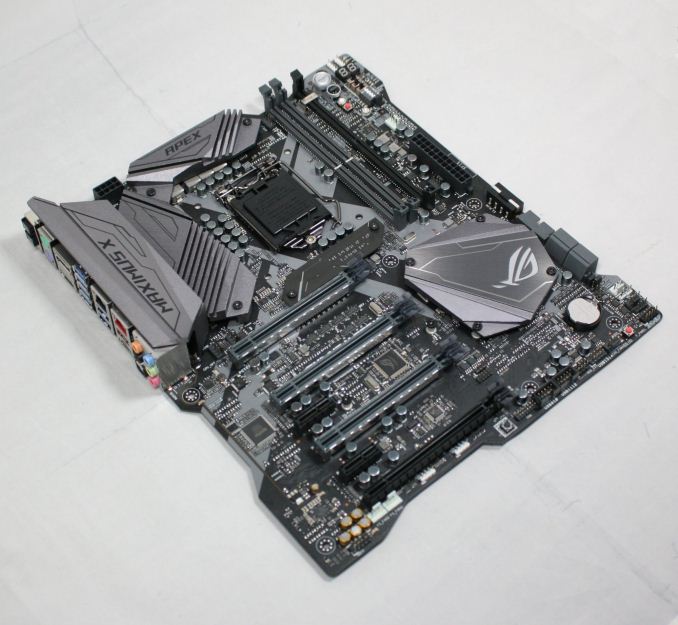
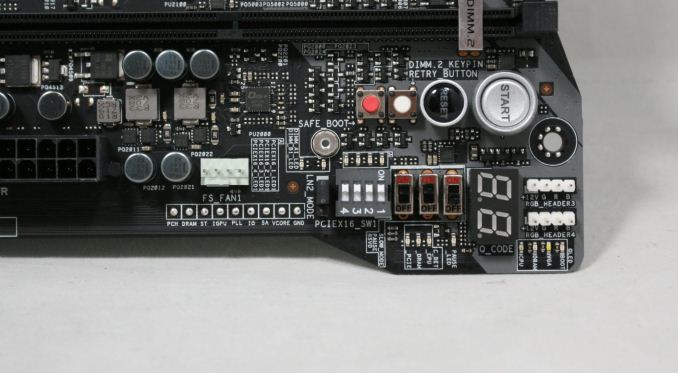
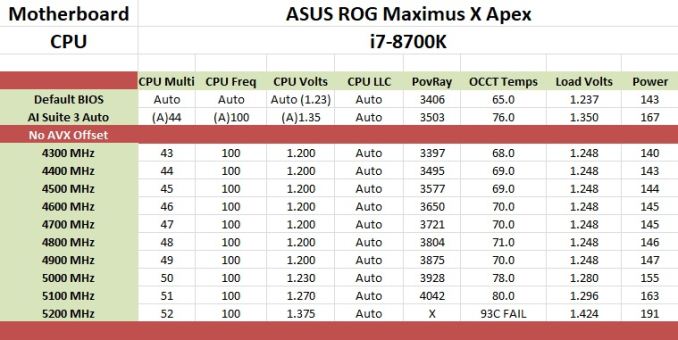
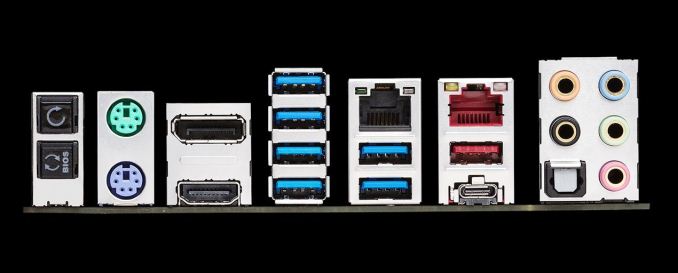
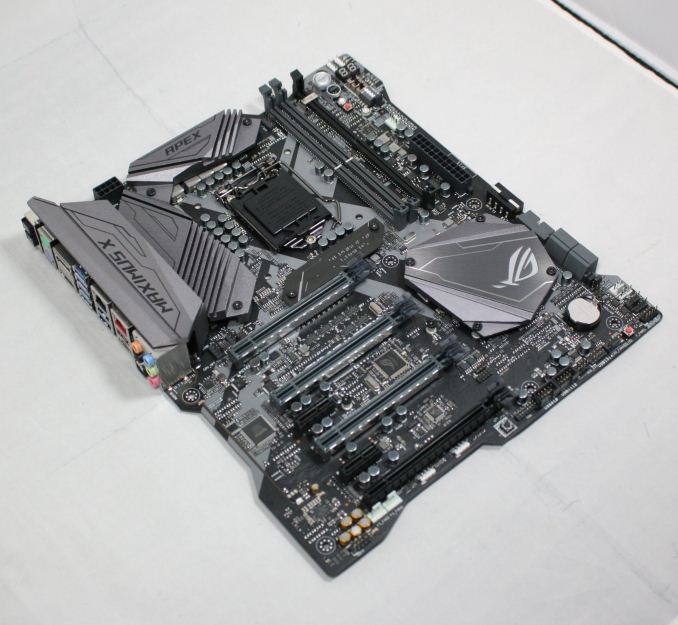








39 Comments
View All Comments
PhrogChief - Saturday, May 12, 2018 - link
LOL...Dragonstongue - Saturday, May 12, 2018 - link
IMO they really should have similar spec non LED/RGB bs motherboards for AMD as well as Intel because there are many (such as myself) that have ZERO need or want for RGB anything taking up the BOM for things that are far more useful.such as put the $ towards giving the best most stable VRM or ensuring the m.2 slots have the best cooling possible without having to resort to liquid (would not hurt them to move them away from right underneath the hottest parts in most computers such as graphics cards/cpu)
why can they not maybe figure out a way to place them right behind the sata/motherboard mains power where there tends to be a nice "hole" that is very rarely occupied with anything)
X shaped LMAO, I was expecting a significant X, but it barely cut the motherboard to give a very slight impression of this (and only if you look really closely)
I very much feel the same though, when you call everything X this or X that, Gaming this or Gaming that, Ultra this or Ultra that, the words lose all meaning, because "everyone is doing it"
ROG is a fine branding, and Hero or Formula or Maximus is also fine, they really do not need to add an even longer name on top of this to try to draw extra attention to it IMO ^.^
mapesdhs - Monday, May 14, 2018 - link
Years ago, the ASUS Sriker II Extreme turned heads, as did the Maximus IV Extreme, and definitely the Rampage IV Extreme. These days, the whole notion of such boards has been rather diluted. Fun stuff like PLX chips has largely gone, while the oc headroom of the latest mainstream Intel chip is garbage (why anyone cares about a 6% bump over the official max turbo is beyond me; at least with SB one could easily reach a 28% bump over the official max turbo, and without the need for Iceland airflow to keep it cool). Oc'ing back in the days of S775, X58, P55 and SB was fun, one could relaly push the hw and see some great gains (sooo many delighted 2500K users out there), but now it's just a giant yawn fest. The CPUs are doing a lot of the oc work automatically, and they're getting good at it.mapesdhs - Monday, May 14, 2018 - link
I meant to add, even outside the ROG line ASUS was doing funky things, eg. the P7P55 WS Supercomputer, x8/x8/x8/x8 on a P55 board! :D I hold most of the P55 3DMark records by plonking three 980s on that whacko board. The P9X79-E WS was similarly and usefully OTT, great for compute yet it has most of the same oc potential of the equiavent ROG board (R4E). Modern mbds have gone RGB bling mad because that's all they have left to tout.Dug - Wednesday, May 16, 2018 - link
I agree with the VRM and m.2 slots.I would really like to know why m.2 slots are in such a hot location.
I'd also like to know why Intel won't increase the lanes needed for more bandwidth to devices.
PhrogChief - Saturday, May 12, 2018 - link
COMING SOON: Asus Republic of Maximus GamerX Type R Ultra Rev 2.0 Extreme X599 MASTER EDITION w-Aura Link LightFlow by Strixm16 - Sunday, May 13, 2018 - link
Interesting, I don't know why this high density RAM was not more of a thing back in the DDR3 days, although I could understand the desire to Overclock and those 16GB DIMMs don't allow that in DDR3 (not to mention that most were also ECC applications).I hope the prices go down, because a 16GB DIMM although not a hard thing to find now, it is still very expensive.
Otherwise, this is an amazing board indeed.
Aikouka - Monday, May 14, 2018 - link
Seems a bit odd to go with a 5Gbps port on an expensive motherboard when ASRock is offering a 10Gbps port on their higher-end board (Z370 Professional Gaming i7). Heck, ASUS even releases stand-alone cards with the same chip that ASRock uses, which is the same company that makes the chip for this board.nimi - Tuesday, May 15, 2018 - link
ASUS be like:A: Guys, slapping on RGB just isn't cutting it anymore, we need something new to stand out.
B: *looks up from his fruit X phone* Notches are all the rage these days, what if we added a NOTCH to our board?
A: I think you're on to something! Hey, why not go one step further, let's do FOUR notches!!! I'll bet it'll sell 4 times as fast!
B: Yes! And add "X" to the name for good measure.
A: BRILLIANT